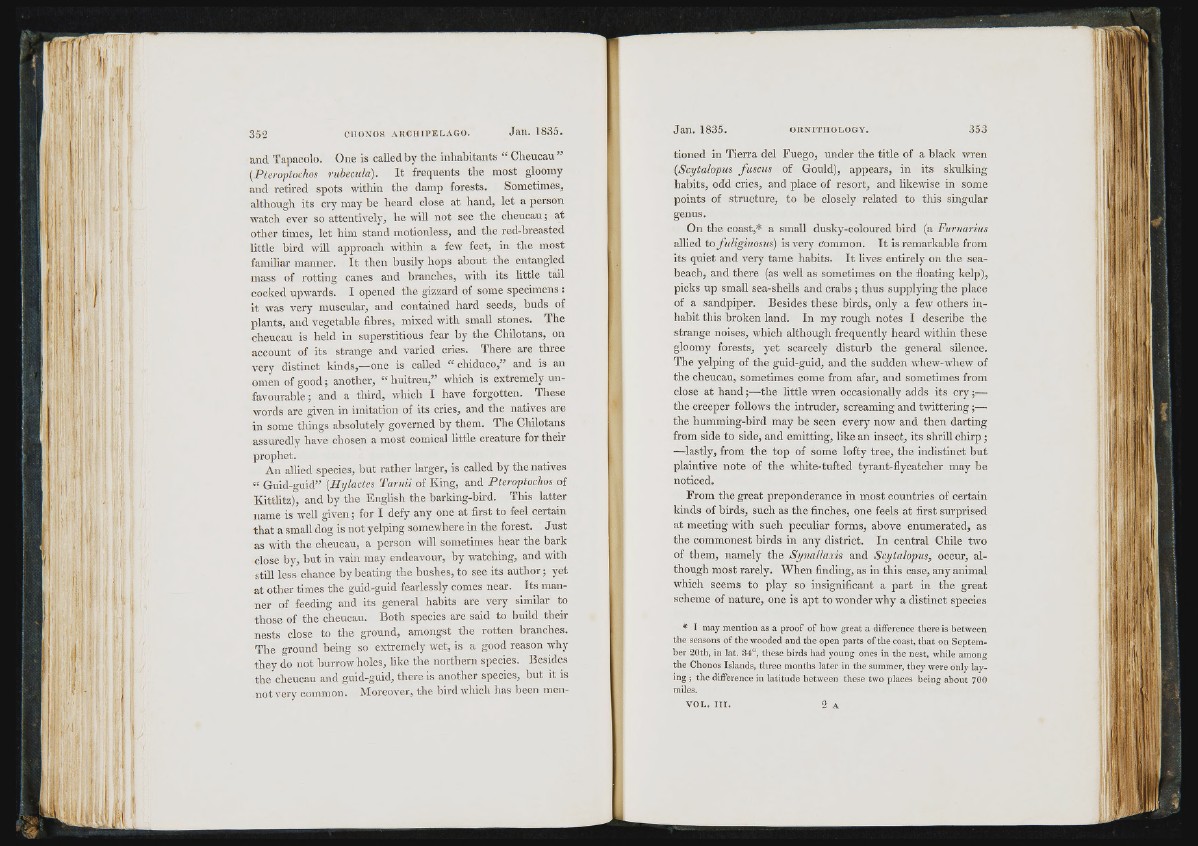
IIV:
li'.. I
71 ■
1 1 ? i|ij!
ft , i
IM -
■i'l;
/ ' I I I j. . H it
- Ml
i : : ft
>
Ì'.
I ÌAWl
and Tapacolo. One is called by the inhabitants “ Cheucau ”
[Pteroptochos vubecula). It frequents the most gloomy
and retired spots within the damp forests. Sometimes,
although its cry may be heard close at hand, let a person
watch ever so attentively, he will not see the cheucau; at
other times, let him stand motionless, and the red-breasted
little bird will approach within a few feet, in the most
familiar manner. It then busily hops about the entangled
mass of rotting canes and branches, with its little tail
cocked upwards. I opened the gizzard of some specimens:
it was very muscular, and contained hard seeds, buds of
plants, aud vegetable fibres, mixed with small stones. The
cheucau is held in superstitious fear by the Chilotans, on
account of its strange and varied cries. There are three
very distinct kinds,—one is called “ chiduco,” and is an
omen of good; another, “ huitreu,” which is extremely unfavour
able; and a third, which I have forgotten. These
words are given in imitation of its cries, and the natives are
in some things absolutely governed by them. The Chilotans
assuredly have chosen a most comical little creature for their
prophet.
An allied species, but rather larger, is called by the natives
« Guid-guid” [Hylactes Tarnii of King, and Pteroptochos of
Kittlitz), and by the English the barking-bird. This latter
name is well given; for I defy any one at first to feel certain
that a small dog is not yelping somewhere in the forest. Just
as with the cheucau, a person will sometimes hear the bark
close by, but in vain may endeavour, by watching, and with
still less chance by beating the hushes, to see its author; yet
at other times the guid-guid fearlessly comes near. Its manner
of feeding and its general habits are very similar to
those of the cheucau. Both species are said to build their
nests close to the ground, amongst the rotten branches.
The ground being so extremely wet, is a good reason why
they do not burrow holes, like the northern species. Besides
the cheucau and guid-guid, there is another species, but it is
not very common. Moreover, the bird which has been mentioiied
in Tierra del Fuego, under the title of a black wren
[Scytalopus fuscus of Gould), appears, in its skulking
habits, odd cries, and place of resort, and likewise in some
points of structure, to be closely related to this singular
genus.
On the coast,* a small dusky-coloured liird (a Furnarius
allied to fuliginosus) is very common. It is remarkable from
its quiet and very tame habits. It lives entirely on the sea-
beach, and there (as well as sometimes on the floating kelp),
picks up small sea-shells and crabs ; thus supplying the place
of a sandpiper. Besides these birds, only a few others inhabit
this broken land. In my rough notes I describe the
strange noises, which although frequently heard within these
gloomy forests, yet scarcely disturb the general silence.
The yelping of the guid-guid, and the sudden whew-whew of
the cheucau, sometimes come from afar, and sometimes from
close at hand;—the little wren occasionally adds its c ry;—
the creeper follows the intruder, screaming and twittering;—
the humming-bird may be seen every now and then darting
from side to side, and emitting, like an insect, its shrill chirp;
—lastly, from the top of some lofty tree, the indistinct but
plaintive note of the white-tufted tyrant-flycatcher may be
noticed.
From the great preponderance in most countries of certain
kinds of birds, such as the finches, one feels at first surprised
at meeting with such peculiar forms, above enumerated, as
the commonest birds in any district. In central Chile two
of them, namely the Synallaxis and Scytalopus, occur, although
most rarely. When finding, as in this case, any animal
which seems to play so insignificant a part in the great
scheme of nature, one is apt to wonder why a distinct species
* I m ay m e n tio n as a p ro o f o f h ow g r e a t a d iffe re n c e th e r e is b e tw e e n
th e se aso n s o f th e w o o d e d a n d th e o p e n p a rts o f tlie c o a st, th a t o n S e p tem b
e r 2 0 th , in la t. 3 4 °, th e s e b ird s h a d y o u n g o n e s in th e n e s t, w h ile am o n g
th e C h o n o s I sla n d s , th r e e m o n th s la t e r in th e s um m e r, th e y w e re o n ly lay in
g ; th e d iffe re n c e in l a t i tu d e b e tw e e n th e s e tw o p la c e s b e in g a b o u t 7 0 0
miles.
V O L . m . 2 A
*
‘ rl